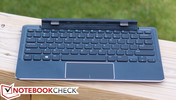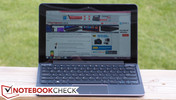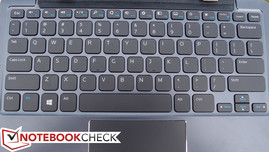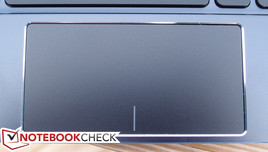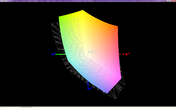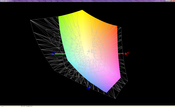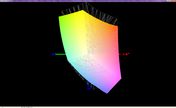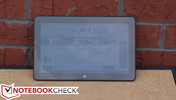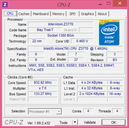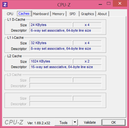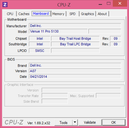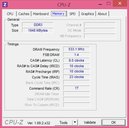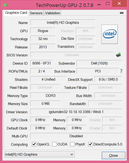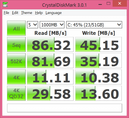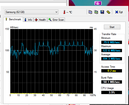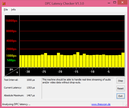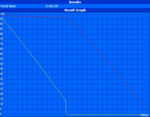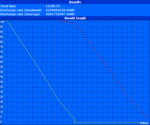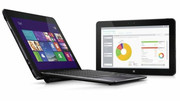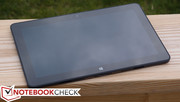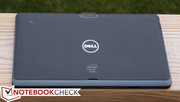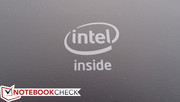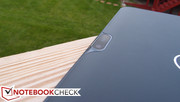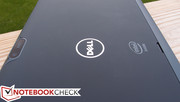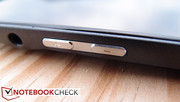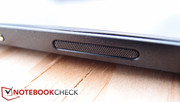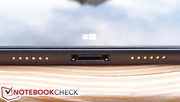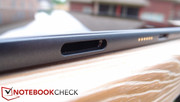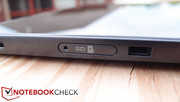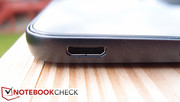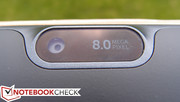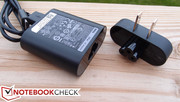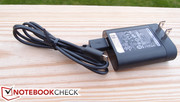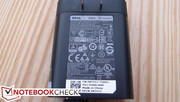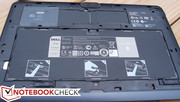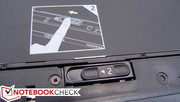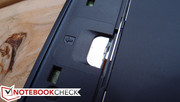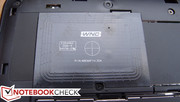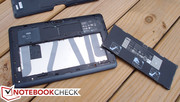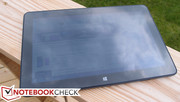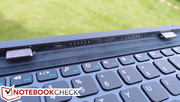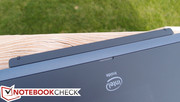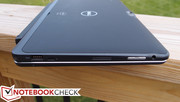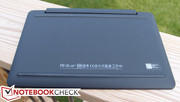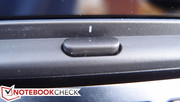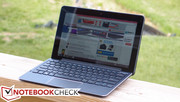Dell Venue 11 Pro 5130 Tablet Review

The Venue 11 Pro might just be the most thoughtful fusion of Dell’s previous tablet ingredients yet. We’re treated to a high-resolution 1080p 10.8-inch screen—the first of any Dell tablet—alongside a quad-core Intel Atom Z3770 SoC (the same as the Lenovo ThinkPad 8 we reviewed a couple months back). Plus, the XPS 10 keyboard dock we saw a year ago has evolved into the Mobility Keyboard, which features not only a reasonably good portable keyboard and touchpad, but also a second battery that greatly extends the device’s already fabulous runtime. All of this is coupled with 2 GB of DDR3-1066 RAM and a 64 GB eMMC for storage in our review unit.
The biggest difference between the Venue 11 Pro and its predecessors is its full range of available options, as well as some other valuable business conveniences such as the inclusion of a swappable battery and better integrated connectivity. Configurations range from $429 at the lowest end of the spectrum all the way up to $1,049 (128 GB SSD, 4 GB RAM, Core i5-4210Y CPU, keyboard base included), which means this is one of the most customizable tablets we’ve seen yet. Our particular configuration is a very affordable $499 MSRP—though again, one thing it does not include is the keyboard base. With this segment of the tablet market steadily expanding, however, can the Venue 11 Pro stand with its competitors?
Case
There’s really nothing particularly unique about the Venue 11 Pro’s case; it is, more or less, par for the course in the world of Windows 8.1 tablets. Although the casing is primarily plastic (in contrast with, say, the Microsoft Surface Pro 2/3’s magnesium), the bottom of the unit is at least outfitted with a rubberized finish to help make it easier to hold. The weight of 760 grams isn’t bad in context with many other similar tablets (for instance, the magnesium-built Microsoft Surface Pro 2 weighs in at 915 grams), but it’s still a bit heavier than other high-end tablets of the comparable size (Google Nexus 10: 603 grams; iPad Air: 464 grams). Relatedly, the dimensions are also a bit larger: 176 mm x 279 mm x 11.9 (h x w x d)—versus the iPad Air’s 7.5 mm D and the Nexus 10’s 8.9 mm D—so the difference is noticeable if not functionally substantial. Fortunately, thanks to the rubberized back and comfortable curved edges, it’s easy to hold and doesn’t feel too cumbersome.
As a necessary byproduct of its removable back (which we’ll cover more in just a moment), the unit does exhibit some characteristic creaks when twisted. But it feels solid regardless, and seems like it should be able to withstand the challenges of a busy workday. Since the screen is an OGS (one-glass solution), it is protected by Corning Concore Glass, which, according to Corning, provides 8 to 10 times better scratch resistance and five times greater compressive strength.
The existence of a removable back panel, meanwhile, makes for easy maintenance and direct access to the unique swappable battery. The screwless design means that it can be removed by simply prying up underneath the large notch with a fingernail, and once removed, it snaps back into place without the need for any tools.
Connectivity
In the realm of connectivity, the Venue 11 Pro gets the job done. Apart from the usual candidates—micro-USB charging port, 3.5 mm headphone jack, volume rocker—you’ll also find a mini-HDMI port, a full-sized USB 3.0 port, and even a docking station port. Plus, there’s an easily-accessible micro-SD slot (supporting up to 128 GB) on the right side, as well as a SIM card slot under the back cover that does not require removal of the battery to access. Placement of the ports is about as sensible as one could expect, with all of them resting on the left and right sides while the unit is docked, and the power button at the top-right.
Communication
Wireless options range from the Dell Wireless 1538 802.11 a/g/n up to the Intel 7260AC dual-band 2x2 802.11ac. Our review unit included the former, which is also a dual-band 2x2 adapter capable of connection speeds up to 300 Mbps and supporting Bluetooth 4.0.
It’s worth mentioning that many users have experienced issues with losing WLAN functionality sporadically. As it turns out, this is just one of a wide number of symptoms of a botched Windows update rollout that affects a number of devices with similar wireless adapters. The problem was supposedly resolved by Microsoft after it was identified, but for systems which already have the updates installed, they must be manually removed to correct the issue (for reference, the updates in question were KB2887595 or KB2903939, and the problem was explained here, though the symptoms are different). On our particular unit, we actually experienced somewhat different issues with the wireless adapter: during extended periods of use, the machine will crash and throw an 0x000000B8 error code (Attempted Switch from DPC Failed). However, this problem appears to be specific to our unit and likely does not affect the model itself.
Accessories and Warranty
Included with the Venue 11 Pro is a rather small 24w, 1.2A power adapter (weighing 108 grams). What’s not included (but what perhaps we’d contend as a practical necessity) is the Dell Tablet Keyboard dock ($160 MSRP), which adds a full-sized Chiclet keyboard, a small but reasonably useful touchpad, and a secondary battery which extends the total battery life by 50%. While there aren’t any additional ports offered, that’s a pretty powerful trifecta of features for a $160 accessory—and one from which we think most businesspeople could easily benefit.
The keyboard dock actually feels as though it’s even more solidly built than the tablet itself, probably due to the need for added weight to help offset the rather jarring sensation of the screen being heavier than the base (opposite that of most notebooks, and not as conducive to lap-based operation). You’ll find a sturdy metal base with silver beveled edges (similar in styling to the Latitude 7000 series notebooks), along with long rubber strips along the base akin to those on the XPS 12 and XPS 13 Ultrabooks. Unlike the tablet itself, the back of the unit is not removable.
The Venue 11 Pro simply snaps onto the top of the keyboard dock with the help of a series of connectors and metal inserts along the edge. Once mounted, the single heavy-duty hinge provides a swivel back to a 117-degree angle, and the unit can also be folded closed like a traditional notebook. The dock seems heavy enough to leave connected if the user prefers. Together, the unit weighs in at 1.436 kg—nowhere near as light as some comparably-sized Ultrabooks (such as the Sony Vaio Pro 11, just 0.86 kg), but still highly portable for a business convertible.
A Dell Tablet Dock accessory ($140 MSRP) also exists, but we didn’t receive one of these for evaluation.
The Dell Venue 11 Pro comes with a one-year in-home warranty (after remote diagnosis) with 90 days premium phone support.
Input Devices
Keyboard and Touchpad
The quality of the separately-sold keyboard is expectedly inferior to that of most full-sized notebooks and even Ultrabooks. The key travel is very short, feedback is only moderately good, and the sizes of the arrow keys and some of the keys along the left side of the keyboard are smaller than usual. Still, it’s far easier to use than any touchscreen virtual implementation. The touchpad (more specifically, a clickpad) is equally cramped, but its surface is comfortable and we were thankful for its inclusion nonetheless. Accuracy, button performance, and gestures were all on par with modern clickpads.
Touchscreen
Also, as is expected from today’s capacitive touchscreens, the Venue 11 Pro’s is perfectly comfortable and accurate to operate. Windows 8.1 gestures were easy to perform and were accurately interpreted by the system.
Display
The Dell Venue 11 Pro features a 10.8-inch 1920x1080 (1080p) glossy IPS screen. That factors out to a usable yet appropriately dense 204 PPI—adequate, yet not excessive. We’re happy to report that the the screen is vibrant and contrast-rich at first sight. It’s detectably brighter than average, and colors appear with sufficient richness.
| |||||||||||||||||||||||||
Brightness Distribution: 83 %
Center on Battery: 391.8 cd/m²
Contrast: 1204:1 (Black: 0.404 cd/m²)
ΔE ColorChecker Calman: 2.3 | ∀{0.5-29.43 Ø4.77}
ΔE Greyscale Calman: 2.47 | ∀{0.09-98 Ø5}
60.49% AdobeRGB 1998 (Argyll 1.6.3 3D)
67.5% AdobeRGB 1998 (Argyll 3D)
90.8% sRGB (Argyll 3D)
65.6% Display P3 (Argyll 3D)
Gamma: 2.16
CCT: 6926 K
We measured 435 cd/m² average brightness across the panel, which is an excellent figure and well above that of most competitors. The decent brightness distribution of 83% means that it’s usually difficult to discern illuminative differences across various quadrants of the screen. Meanwhile, we calculated a very good contrast ratio of 1204:1 (thanks to the 0.404 cd/m² black value). These figures together really contribute to the screen’s pop under maximum brightness.
But what about cover coverage and accuracy? Our measurements of the panel’s color space revealed a coverage of 81% of sRGB, which is quite good for a business PC, though the device clearly wasn’t meant to suffice for photography or graphic design professionals.
CalMAN 5 provides a deeper look into the color reproduction. Even in its pre-calibrated state, the Venue 11 Pro does a perfectly fine job of approximating accurate color. The total gamma of 2.16 is very close to the ideal value of 2.2, and the average DeltaE of just 2.3 means that, on the whole, color reproduction is very good. In fact, not a single color exceeds the 4 DeltaE mark apart from white alone, which is just 4.01 itself. That means that, at least to the average human eye, it would be very difficult to detect any notable aberrations.
As is typically the case with glossy screens, it is difficult to comfortably view the Venue 11 Pro under direct sunlight—but, thanks to the panel’s excellent brightness and contrast, it is indeed possible. With some adjustments to the Intel Graphics driver settings, the maximum brightness improves while operating on battery and the situation becomes better still. Operation in shaded areas is not a problem. Finally, viewing angles are as good as any IPS panel can provide: we had no trouble even when approaching from extreme angles.
Performance
Further emphasizing the wide range of options available for the Venue 11 Pro’s configuration is the CPU selection. At the low end is an Intel Atom Z3770 with a TDP of around 4 W (SDP of 2 W), while at the top of the list is the Intel Core i5-4210Y with a TDP of closer to 11.5W (SDP of 6 W). Coupled with 2 GB of DDR3L-1066 RAM, our test candidate features the Atom Z3770, which is a quad-core SoC from the Bay Trail-T platform whose clock rates range from 1.46 to 2.4 GHz.
Performance when running on battery power is notably diminished; a subsequent run of 3DMark 06 while unplugged provided a total score of 1298 and a CPU score of 1453, well below our initial values of 1848 and 2203 (respectively). Finally, DPC Latency Checker revealed no detectable issues handling real-time video and audio streaming.
Processor
The Atom Z3770’s performance is significantly better than that of previous Atom CPUs. In spite of some comparative performance fluctuations, it can be seen in the same group as the Pentium Dual Core T4200 and even the Core i5-2537M depending on the results one chooses to examine. As it compares to the higher-end Core i5-4210Y option, it’s nearly always much slower (as much as 50% slower, in fact), barring a few outliers such as 3DMark 06 CPU and wPrime.
When comparisons are made with other tablets powered by the same SoC, meanwhile, the Venue 11 Pro fares appropriately well. It’s comparable to the well-received ThinkPad 8 in most respects and generally close enough to the HP Omni 10 5600eg (with the exception of Super Pi 32M, where the Omni scores around 10% faster—1566 versus 1735 seconds, specifically).
As for how the Venue 11 Pro 5130’s Atom CPU stands in comparison to the i3-powered model, there are few surprises. The i3 model takes the crown in nearly every category; for example, it is 26% faster in 3DMark 11 Performance Physics (1908 vs. 1510) and 30% faster in Super Pi 32M (1220 seconds vs. 1735 seconds). Considering the higher price and TDP of the i3 model, however, this is to be expected.
System Performance
Our synthetic benchmarks of the Venue 11 Pro 5130 reveal the expected Achilles’ Heel of using inexpensive eMMC storage versus a full-blown SSD. While the device still feels snappy enough moving through lightweight activities, it buckles during heavier sessions, especially those requiring a lot of storage access or CPU operation.
When compared to the ThinkPad 8, the Venue 11 Pro 5130 comes out on top in both of our synthetic application performance benchmarks, scoring 2665 and 5946 versus the ThinkPad’s 2560 and 5229 in PCMark 7 and Vantage, respectively. Those certainly aren’t bad scores, but in comparison with modern Ultrabooks and tablets which employ solid-state drives, they’re quite a bit lower. Again, as an example of this, the Venue 11 Pro i3 model fares roughly 44% better, with a score of 3843 in PCMark 7.
| PCMark Vantage Result | 5946 points | |
| PCMark 7 Score | 2665 points | |
Help | ||
Storage Devices
The reason for the below-average performance when compared to the i3 model and other such devices is the inclusion of a Samsung MCG8GC eMMC card (formatted to 58 GB usable capacity). This card is still better performing than some notebook hard drives, but its Sequential Read/Write scores in CrystalDiskMark 3.0 of 86.32 MB/s and 45.15 MB/s absolutely pale in comparison to the Venue 11 Pro i3 model’s 239.6 MB/s and 147.8 MB/s, and even those scores are fairly low for a modern SSD. Similarly, in HD Tune, the 104.3 MB/s Transfer Rate Average is leagues below the 325.3 MB/s score of the higher-end configuration. Neverthless, for the most part, the results beat those of the ThinkPad 8, with 4K reads leading the pack with 40—80% better results, and an HD Tune Transfer Rate Average which is 40% better in comparison (vs. 61.9 MB/s). The sole exception is the CDM Sequential Read result, where we saw a 43% better performance from the ThinkPad 8, oddly enough.
GPU Performance
The Venue 11 Pro is hardly meant to be any sort of gaming connoisseur, and as such, we will spend very little time focusing on its performance in this category. Its total score of 212 in 3DMark 11 tells the story; while it has no trouble handling high-resolution video output and smooth video playback, 3D performance is extremely limited, primarily due to the passive cooling approach. As evidenced by our sole gaming benchmark (Diablo III, where we recorded just 15 fps on low settings, 1024x768 resolution), only very old and low-requirement games even have a remote chance at qualifying as playable on the tablet. In comparison, the i3 model—while still hardly an option for anyone interested in 3D gaming on the go—manages 509 in 3DMark 11, for a performance premium of 140%.
| 3DMark 03 Standard | 5323 points | |
| 3DMark 05 Standard | 3445 points | |
| 3DMark 06 Standard Score | 1848 points | |
| 3DMark Vantage P Result | 628 points | |
| 3DMark 11 Performance | 212 points | |
Help | ||
| low | med. | high | ultra | |
|---|---|---|---|---|
| Diablo III (2012) | 14.8 | 11.4 | 9.6 | 5.9 |
Emissions
Temperature
Temperature is not the Venue 11 Pro’s strong suit. For instance, for idle temperatures, we recorded average values of 31.5°C and 32.4°C on the top and bottom of the tablet (versus the ThinkPad 8’s 30.5°C and 30.3°C—and even that device isn’t considered cool). Under load, things predictably heat up a lot, with average temperatures of 36.5°C and 38.7°C on top and bottom (ThinkPad 8: 38.9°C and 37.3°C) and maximum values of 44.4°C and 53.4°C in those same regions (ThinkPad 8: 43.2°C and 41.2°C).
(±) The maximum temperature on the upper side is 44.4 °C / 112 F, compared to the average of 33.7 °C / 93 F, ranging from 20.7 to 53.2 °C for the class Tablet.
(-) The bottom heats up to a maximum of 53.4 °C / 128 F, compared to the average of 33.2 °C / 92 F
(+) In idle usage, the average temperature for the upper side is 31.5 °C / 89 F, compared to the device average of 30 °C / 86 F.
Stress Test
During our stress testing, the Venue 11 Pro handled the heat surprisingly well as compared to smaller rivals such as the ThinkPad 8. Whereas the ThinkPad immediately throttles its clock speeds under any and all combinations of CPU and GPU stress, the Venue 11 Pro manages stable a 1466 MHz across all cores under full CPU stress (the base clock rate) and 667 MHz (the maximum clock rate) on the GPU front. Temperatures under GPU stress are much higher than while CPU-only load is imposed, with a maximum recorded sensor temperature reading of 73°C versus 52°C for CPU load.
Finally, with both CPU and GPU load applied, the CPU still manages 1466 MHz across all cores (thus no throttling), but the GPU throttles finally to 311 MHz and remains there. Temperatures again reach 73°C.
We performed a subsequent run of 3DMark 06 to discern whether the recorded GPU throttling would affect the system, and our result was indeed lower: we recorded 1807 on our second run versus 2203 during our regular round of benchmarking (18% lower).
Speakers
While the Venue 11 Pro’s two edge-mounted speakers provide ample enough volume, they predictably lack any sort of accurate mid- and low-end signal reproduction. It is usable audio for very basic needs, but nothing more. Fortunately, a headphone jack and Bluetooth connectivity are available for external output instead.
Battery Life
Partially thanks to some of the stability issues we mentioned earlier in our review (on our particular unit), battery tests on the Venue 11 Pro were a challenge. Furthermore, Battery Eater Pro doesn’t like to cooperate with the device, so our typical graph output is limited to the test cases with the keyboard base attached (oddly enough).
Nevertheless, our results were encouraging to say the least. The Venue 11 Pro has enough juice and frugality to last the whole of a typical workday for business folks, managing a maximum runtime of 13 hours and 55 minutes (Airplane Mode enabled, brightness minimum, Battery Eater Pro Reader’s Test), a minimum runtime of still 3 hours and 34 minutes (max brightness, Battery Eater Pro Classic Test), and—perhaps most tellingly—a recorded 9 hours and 10 minutes while surfing with medium brightness. That practically matches the iPad Air’s result and it beats the Venue 11 Pro i3 model’s time by two and a half hours.
Things improve even more with the keyboard base (which serves as a secondary battery) attached. We saw 5 hours and 40 minutes under load, and 14 hours and 8 minutes while surfing. That’s an average premium of 64% longer runtimes, which is above Dell’s claim of 50% better battery life while attached. See our graphs above and to the right for illustrations of the discharge rates for both batteries while the keyboard base is attached.
Verdict
Those searching for a larger-sized tablet with an acceptable detachable keyboard and touchpad, great battery life, a bright, vivid screen, and full-blown Windows 8.1 should seriously consider the merits of the Venue 11 Pro. It has all of these, plus a full-sized USB 3.0 port on the tablet itself, mini-HDMI/micro-SD, and easy battery access via a screwless rear panel. Best of all, it’s just $499 MSRP (as configured) without the base, so it’s surprisingly affordable, too. Add in the base (which we personally consider to be a necessity) for another $160 and you’ve got a pretty capable convertible tablet for under $700.
The list of caveats begins with the performance constraints; while the Atom Z3770 SoC is certainly much more powerful than the previous generation of these chips, it’s still well below that of a comparable Core i5 ULV CPU. The same applies to the Samsung eMMC storage device, which pales in comparison to most of today’s modern SSDs. Fortunately, these two concerns can be resolved by simply stepping up to an i3 configuration (and adding a keyboard base), or perhaps even an i5 model, which includes an SSD in lieu of the eMMC and carries a price of around $1,049 MSRP (comparable to that of a similarly-equipped Surface Pro 3, which is $999). The unit also is a bit on the heavy side for a tablet, even with its principally plastic construction considered. Finally, it heats up rather significantly under load. Those interested in something smaller with a few key sacrifices might still be more enticed by the Dell Venue 8 Pro, which features a similar configuration but a lower-quality screen, a lack of video output and USB ports, shorter battery life, and no physical docking options—all for around $229 MSRP.
But for the price and the feature set—especially considering such benefits as the excellent battery life—the Venue 11 Pro 5130 is a versatile device with a lot of potential when in the right hands.










